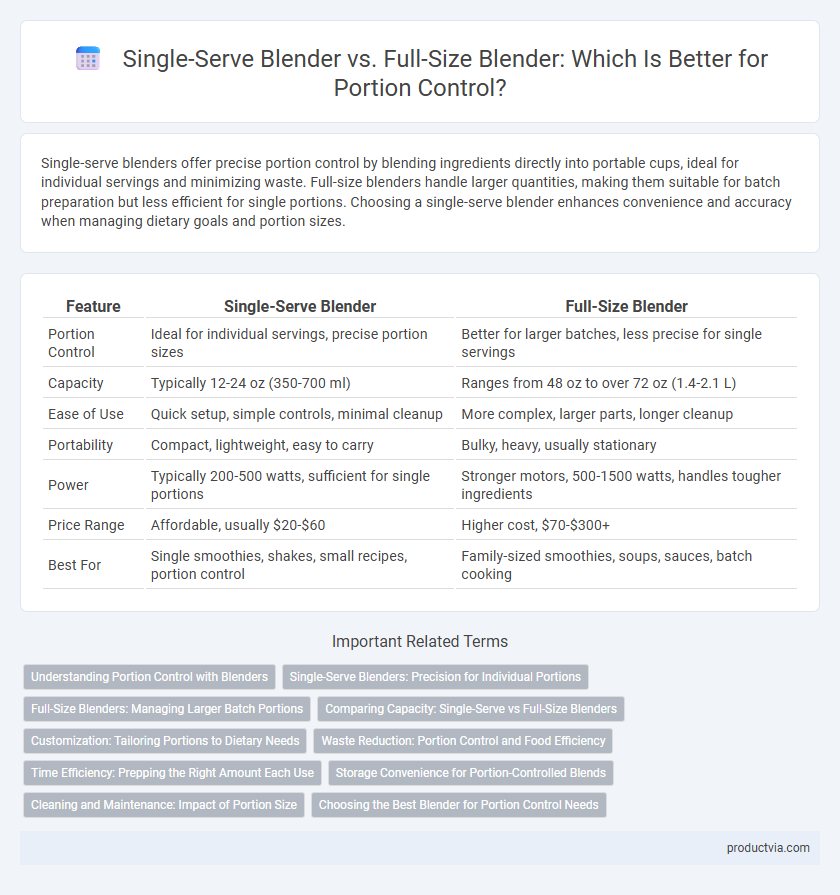Single-serve blenders offer precise portion control by blending ingredients directly into portable cups, ideal for individual servings and minimizing waste. Full-size blenders handle larger quantities, making them suitable for batch preparation but less efficient for single portions. Choosing a single-serve blender enhances convenience and accuracy when managing dietary goals and portion sizes.
Table of Comparison
| Feature | Single-Serve Blender | Full-Size Blender |
|---|---|---|
| Portion Control | Ideal for individual servings, precise portion sizes | Better for larger batches, less precise for single servings |
| Capacity | Typically 12-24 oz (350-700 ml) | Ranges from 48 oz to over 72 oz (1.4-2.1 L) |
| Ease of Use | Quick setup, simple controls, minimal cleanup | More complex, larger parts, longer cleanup |
| Portability | Compact, lightweight, easy to carry | Bulky, heavy, usually stationary |
| Power | Typically 200-500 watts, sufficient for single portions | Stronger motors, 500-1500 watts, handles tougher ingredients |
| Price Range | Affordable, usually $20-$60 | Higher cost, $70-$300+ |
| Best For | Single smoothies, shakes, small recipes, portion control | Family-sized smoothies, soups, sauces, batch cooking |
Understanding Portion Control with Blenders
Single-serve blenders offer precise portion control by allowing users to blend individual servings directly in personal-sized containers, reducing the risk of overconsumption and food waste. Full-size blenders typically produce larger quantities, which may encourage larger portion sizes and make it harder to monitor intake accurately. Choosing a single-serve blender supports controlled, customizable portions ideal for nutrition-conscious users aiming to manage calorie intake effectively.
Single-Serve Blenders: Precision for Individual Portions
Single-serve blenders excel in delivering precise, controlled portions ideal for personalized smoothies and meal prep, minimizing waste and ensuring nutritional accuracy. Their compact design and targeted blending capacity optimize convenience and efficiency for single servings, unlike full-size blenders designed for bulk blending. This precision aligns perfectly with dietary goals, portion control, and on-the-go lifestyles.
Full-Size Blenders: Managing Larger Batch Portions
Full-size blenders excel at managing larger batch portions, making them ideal for meal prepping and family-sized servings. They typically offer more powerful motors and larger capacity pitchers, allowing for efficient blending of ingredients in bulk without compromising texture or consistency. Their versatility supports portion control by enabling users to divide blended content into precise servings, reducing food waste and ensuring balanced nutrition.
Comparing Capacity: Single-Serve vs Full-Size Blenders
Single-serve blenders typically offer capacities ranging from 12 to 32 ounces, making them ideal for precise portion control and individual servings of smoothies or shakes. Full-size blenders, with jars holding 48 ounces or more, can handle larger quantities suited for family meals but may lead to excess servings if portion sizes are not carefully measured. Choosing a single-serve blender supports better management of calorie intake and reduces food waste by blending only the desired amount.
Customization: Tailoring Portions to Dietary Needs
Single-serve blenders offer precise portion control by allowing users to customize serving sizes aligned with dietary needs, ideal for individual meals or snacks. Full-size blenders cater to larger batches but may lack the granularity required for strict portion management, often leading to overconsumption. Customizing portions in single-serve blenders supports calorie control, nutrient-specific blending, and personalized meal planning essential for dietary compliance.
Waste Reduction: Portion Control and Food Efficiency
Single-serve blenders promote waste reduction by allowing precise portion control, minimizing leftover ingredients compared to full-size blenders that often require larger batches. These compact blenders optimize food efficiency by blending only the needed amounts, reducing spoilage and saving resources. Utilizing single-serve blenders supports sustainable kitchen habits by curbing excess food waste and energy consumption.
Time Efficiency: Prepping the Right Amount Each Use
Single-serve blenders enhance time efficiency by enabling users to prep exact portions for each use, minimizing cleanup and reducing food waste. Full-size blenders excel at handling larger batches but demand longer preparation and cleaning times, making them less ideal for quick, single servings. Choosing a single-serve blender streamlines meal prep, optimizing portion control without sacrificing convenience.
Storage Convenience for Portion-Controlled Blends
Single-serve blenders excel in storage convenience due to their compact size and portable design, making them ideal for portion-controlled blends that require minimal counter space. Full-size blenders, while offering larger capacity and powerful motors, often require dedicated storage areas and can be cumbersome for small, single-serve recipes. Choosing a single-serve blender optimizes both countertop clutter reduction and quick cleanup, enhancing efficiency in managing precise portion sizes.
Cleaning and Maintenance: Impact of Portion Size
Single-serve blenders offer easier cleaning and maintenance due to their compact size and fewer components, making them ideal for precise portion control and quick use. Full-size blenders, while versatile and powerful for larger batches, often require more time-intensive cleaning because of larger blades and bigger jars. Choosing a single-serve blender simplifies maintenance routines and enhances efficiency when managing small, controlled portions.
Choosing the Best Blender for Portion Control Needs
Single-serve blenders offer precise portion control with their compact size and single-cup capacity, ideal for individual smoothies or protein shakes without excess waste. Full-size blenders provide versatility for batch preparation but may require careful measurement to avoid over-serving. Choosing the best blender for portion control depends on balancing convenience, capacity, and the type of recipes frequently prepared.
Single-serve blender vs full-size blender for portion control Infographic

 productvia.com
productvia.com